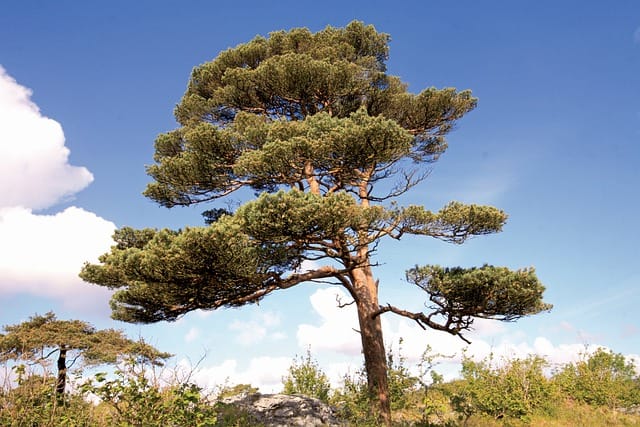Identifying Scots Pine trees
The Scots Pine tree, scientifically known as Pinus sylvestris, is a coniferous evergreen native to Europe and Asia

In this article:
Introduction
The Scots Pine tree, scientifically known as Pinus sylvestris, is a coniferous evergreen native to Europe and Asia. It is one of the most common and recognizable tree species. This article aims to guide you in identifying the Scots Pine tree by focusing on its physical characteristics, preferred habitat, key features, unique properties, and conservation status.
Physical characteristics of the Scots Pine tree
The Scots Pine tree typically grows between 15 to 35 meters in height, with a straight trunk and a conical or rounded crown. Its bark starts out as a reddish-brown color, gradually turning darker and becoming cracked as the tree ages. The needles and cones of the Scots Pine tree hold vital clues for identification.
Preferred habitat and distribution
Scots Pine trees prefer well-drained soils, especially sandy or rocky terrain. They can withstand harsh environmental conditions like strong winds, making them suitable for open landscapes such as moors, heaths, and mountainsides. These trees are widely distributed throughout Europe, including countries such as Scotland, Norway, Sweden, and Russia.
Key identifying features of the Scots Pine tree
a. Needles
The needles of the Scots Pine tree generally come in pairs and appear in bundles of two to five. They are bright green in color, measuring around 4 to 7 centimeters in length. These needles remain on the tree for several years before turning yellow and eventually falling off.
b. Cones
The cones are an essential feature for identifying the Scots Pine tree. They are oval-shaped and start off green, eventually maturing into brown or reddish-brown. The cones measure around 5 to 8 centimeters in length and can persist on the tree for years after they have shed their seeds.
c. Bark
Young Scots Pine trees have smooth bark with a reddish-brown color. As the tree ages, the bark becomes rougher, darker, and develops distinctive fissures. These cracked patterns on the bark help differentiate the Scots Pine from other species.
d. Form and growth pattern
The Scots Pine tree has an overall conical shape in its youth, gradually becoming more irregular with age. It often develops a twisting and leaning appearance due to its adaptability to different environmental conditions. The lower branches tend to droop, creating a characteristic upswept form.
Unique properties and uses of the Scots Pine tree
The Scots Pine tree has several unique properties and uses. Its wood is highly prized for construction, furniture-making, and fuel due to its durability and natural resistance to decay. The needles and bark are a source of therapeutic essential oils and have been used for centuries for medicinal purposes.
Similar tree species and how to differentiate them
Among the similar tree species, the Lodgepole Pine (Pinus contorta) and the Dwarf Mountain Pine (Pinus mugo) bear some resemblance to the Scots Pine. However, the Lodgepole Pine has longer needles and curved cones, while the Dwarf Mountain Pine has shorter needles and smaller cones. Observing these distinguishing features will help differentiate between the species.
Conservation status and efforts
The Scots Pine tree is not currently classified as a globally threatened species. However, in some regions, habitat loss and unsustainable logging practices have led to a decline in their population. Conservation efforts focus on protecting their natural habitats and promoting sustainable management practices to ensure the long-term survival of this iconic tree.
Conclusion
The Scots Pine tree is a beautiful and significant species, recognized for its adaptability, unique features, and various uses. By considering the physical characteristics, preferred habitat, key features, and unique properties of this tree, you can confidently identify the Scots Pine and appreciate its importance in the natural world.
